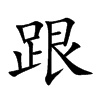Good Dictionary is the free online xinhua dictionary query website,
All content comefrom the network, please notify us if there is any infringement to delete.
Good Dictionary both Chinese characters dictionary, Chinese Dictionary, and the main functions of the encyclopedia.
Provide you with including the explanation of Chinese characters, the origin of Chinese characters,
the evolution of Chinese characters, Chinese Etymology, calligraphy dictionary, Chinese character history and ancient Chinese character, etc.
Good Dictionary is a large-scale comprehensive network of Chinese dictionaries,
We will continue to enrich and perfect the dictionary, in order to help users better.
Character AttributesStroke Order
| и·ҹ | Simplified | и·ҹ | Traditional | и·ҹ | |
| Pinyin | gД“n | Zhuyin | г„Қг„Ј | ||
| Radicals | и¶і | Radicals Stroke | 6 | ||
| Character Stroke | 13 | Structure | е·ҰеҸіз»“жһ„ | ||
| Orthography | еҪўеЈ°пјӣд»Һи¶ігҖҒиү®еЈ° | WuBi 86 | khve | ||
| WuBi 96 | khvy | Cang Jie | rmav | SiJiao | 67132 |
| ZhengMa | jixo | gb2312 | B8FA | Big5 | B8F2 |
| Five Element | жңЁ | HSK Grade | з”Ізә§ | Frequently-used | еёёз”Ё |
| Fore Aft | и¶іиү® | Components | и¶іиү® | ||
| Unicode | U+8DDF | Variant Character | рЁҒһрЈҘҰ | ||
| Visitor | 19279 | Update | 2024-06-01 | ||
| Previous | иҳ” | Next | й—¶ | ||
Stroke Numberпјҡ2512121511534
Stroke Writingпјҡз«–жҠҳжЁӘз«–жЁӘз«–жЁӘжҠҳжЁӘжЁӘжҠҳж’ҮжҚә
gД“n
з«–
жЁӘжҠҳ
жЁӘ
з«–
жЁӘ
з«–
жҸҗ
жЁӘжҠҳ
жЁӘ
жЁӘ
з«–жҸҗ
ж’Ү
жҚә
Basic ExplanationExample Sentence
и„ҡзҡ„еҗҺйғЁпјҢиёөпјҡи„ҡеҗҺпҪһгҖӮ
йһӢиўңзҡ„еҗҺйғЁпјҡй«ҳпҪһйһӢгҖӮиўңеҗҺпҪһе„ҝгҖӮ
йҡҸеңЁеҗҺйқўпјҢзҙ§жҺҘзқҖпјҡпҪһйҡҸгҖӮпҪһиёӘгҖӮ
иө¶пјҢеҸҠпјҡпҪһдёҚдёҠзҸӯгҖӮ
е’ҢпјҢеҗҢпјҡжҲ‘пҪһд»–еңЁдёҖиө·е·ҘдҪңгҖӮ
еҜ№пјҢеҗ‘пјҡжҲ‘е·Із»ҸпҪһд»–иҜҙдәҶгҖӮ
- Example Sentence
It was not a question of granting new rights to broadcasting organizations, but just to keep track of technological innovations.
й—®йўҳдёҚжҳҜеҗ‘е№ҝж’ӯз»„з»ҮжҺҲдәҲж–°зҡ„жқғеҲ©пјҢиҖҢд»…д»…жҳҜдёәдәҶи·ҹдёҠжҠҖжңҜеҲӣж–°гҖӮWoman married to a man, at the moment of marriage, she is already determined to love and live with this man for her life.
еҘідәәе«Ғз»ҷеҘҪз”·дәәпјҢе«Ғзҡ„йӮЈеҲ»пјҢжҳҜдёӢдәҶеҶіеҝғи·ҹз”·дәәеҘҪеҘҪиҝҮж—Ҙеӯҗзҡ„гҖӮWe go all over Europe playing top teams and we play against the best sides in this country, but that was one of the hardest games we've had.
жҲ‘们已з»Ҹи·ҹ欧жҙІеҲ—ејәе’Ңжң¬еӣҪиұӘй—ЁдәӨжүӢиҝҮеӨҡж¬ЎпјҢдҪҶиҝҷжҳҜжҲ‘иёўиҝҮзҡ„жңҖеӣ°йҡҫзҡ„жҜ”иөӣд№ӢдёҖгҖӮBut I guess so, would it be so selfish for me to ask the same thing, wouldn't it?
жҲ‘д№ҹеёҢжңӣдҪ и·ҹжҲ‘жғіеҫ—дёҖж ·пјҢдҪҶиҝҷдёӘжғіжі•дјјд№ҺеӨӘиҝҮиҮӘз§ҒпјҹSeru smiled. "You were right, Kiah, " she said. "Those satellite numbers were very bad. I began to tell Gog, but he didn't listen to me. "
еЎһйІҒ笑дәҶгҖӮвҖңдҪ иҜҙеҫ—еҜ№пјҢеҮҜпјҢвҖқеҘ№иҜҙпјҢвҖңйӮЈдәӣеҚ«жҳҹж•°жҚ®зҡ„зЎ®еҫҲзіҹзі•гҖӮжҲ‘иҜ•зқҖи·ҹй«ҳж јиҜҙпјҢеҸҜд»–ж №жң¬дёҚеҗ¬жҲ‘зҡ„гҖӮвҖқI'm afraid I can't go dancing with you guys tonight. I've got to go home and feed my pet turtle.
жҲ‘д»ҠжҷҡжҒҗжҖ•дёҚиғҪи·ҹдҪ 们еҺ»и·іиҲһдәҶгҖӮжҲ‘еҫ—еӣһ家е–ӮжҲ‘зҡ„е® зү©йҫҹгҖӮAnd also any other things you can share with us about how the United States military is preparing to take on whatever in the next few days?
дҪ иҝҳиғҪи·ҹжҲ‘们иҜҙиҜҙпјҢзҫҺеӣҪеҶӣйҳҹеңЁжҺҘдёӢжқҘзҡ„еҮ еӨ©еҮҶеӨҮеҒҡд»Җд№Ҳеҗ—пјҹAt the door, with his blackest, most evil expression, Heep turned and said to me, ' I've always hated you, Copperfield!
иө°еҲ°й—ЁеҸЈпјҢеёҢжҷ®иҪ¬иҝҮиә«пјҢеёҰзқҖжңҖйҳҙжҡ—гҖҒжңҖйӮӘжҒ¶зҡ„иЎЁжғ…и·ҹжҲ‘иҜҙйҒ“пјҡвҖңжҲ‘ж—©е°ұжҒЁдҪ пјҢ科波иҸІе°”пјҒвҖқHalf the time I had to grub cigarettes from the students, and during the lessons sometimes I munched a bit of dry bread with them.
жңүдёҖеҚҠзҡ„ж—ҘеӯҗйҮҢжҲ‘еҫ—еҗ‘еӯҰз”ҹи®ЁзғҹжҠҪпјҢжңүж—¶жӯЈдёҠзқҖиҜҫжҲ‘е°ұи·ҹ他们дёҖиө·е•ғејҖдәҶдёҖзӮ№е№Іе„ҝйқўеҢ…гҖӮ
Glyph Evolution(Chinese Etymology,Chinese character and etymology research)

иӘӘж–ҮвҖ§и¶ійғЁ

иӘӘж–ҮжҲ–й«”

жҘ·жӣё
Chinese Calligraphy Art of Good Dictionary
KaishuXingshuCaoshuLishuZhuanshuOther
Kaishu Calligraphy

йўңзңҹеҚҝ-жҘ·д№Ұ: и·ҹ
Xingshu Calligraphy

йҷҶжҹ¬д№Ӣ-иЎҢд№Ұ: и·ҹ

欧йҳіиҜў-иЎҢд№Ұ: и·ҹ

敬世жұҹ-иЎҢд№Ұ: и·ҹ
Caoshu Calligraphy

жҜӣжіҪдёң-иҚүд№Ұ: и·ҹ

敬世жұҹ-иҚүд№Ұ: и·ҹ

еҫҗдјҜжё…-иҚүд№Ұ: и·ҹ
Lishu Calligraphy

жӣ№е…Ёзў‘-йҡ¶д№Ұ: и·ҹ
Good dictionary did not find the relevant information of the Chinese character и·ҹ.
Good dictionary did not find the relevant information of the Chinese character и·ҹ.
Chinese EtymologyпјҲChinese character history and ancient Chinaese characterпјү
Oracle charactersBronze charactersLiushutong charactersSeal characters
Good dictionary did not find the relevant information of the Chinese character и·ҹ.
Good dictionary did not find the relevant information of the Chinese character и·ҹ.
Good dictionary did not find the relevant information of the Chinese character и·ҹ.
Origin of Chinese Characters

и·ҹ-S01488

и·ҹ-S01489
Comparison of characters(Glyph Contrast)

дёӯеӣҪеӨ§йҷҶ

еҸ°ж№ҫ

йҰҷжёҜ

ж—Ҙжң¬

йҹ©еӣҪ

ж—§еӯ—еҪў
Chinese phrases(Common Phrases)
и·ҹзҸӯ gД“n bДҒn
и·ҹзҸӯ gД“n bДҒn
и·ҹеҢ… gД“n bДҒo
[work as a footman, servant of an official]вҲ¶ж—§жҢҮдё“дёәжҹҗдёӘжҲҸжӣІжј”е‘ҳз®ЎзҗҶжңҚиЈ…гҖҒеҒҡжқӮеҠЎзӯү
и·ҹе·® gД“n chДҒi
[attendant] ж—§жҢҮе®ҳеҗҸиә«иҫ№дҫӣе·®йҒЈзҡ„йҡҸд»Һ;и·ҹдёҒ
и·ҹд»Һ gД“n cГіng
[suite]вҲ¶и·ҹйҡҸ;йҡҸд»Һ
и·ҹи…ұ gД“n jiГ n
[achilles tendon] е“әд№іеҠЁзү©е°Ҹи…ҝи…“иӮ йғЁеӨ§иӮҢиӮүзҡ„и…ұиҒ”еҗҲеҪўжҲҗзҡ„ејәжңүеҠӣи…ұ,жӯўдәҺи¶іи·ҹйӘЁ
и·ҹи„ҡ gД“n jiЗҺo
[fit the feet perfectly] гҖҲж–№гҖүвҲ¶жҢҮйһӢзҡ„е°әеҜёеҫҲеҗҲи„ҡ
и·ҹеүҚ gД“n qiГЎn
[in front of;near;be close to]вҲ¶йқўеүҚ,йҷ„иҝ‘--еҚ•з”Ё,еүҚйқўжІЎжңүеҗҚиҜҚ
д»–йқ еңЁжІҷеҸ‘дёҠ,и·ҹеүҚжңүдёҖеӨ§е Ҷд№ҰжҠҘ
и·ҹдәә gД“n rГ©n
и·ҹдәә gД“n rГ©n
и·ҹдёҠ gД“n shГ ng
[catch up with]вҲ¶еңЁжҲҗе°ұжҲ–зү©иҙЁзҡ„иҺ·еҸ–дёҠ,дёҺеҗҢж—¶д»Јзҡ„дәәзӣёй…Қ
и·ҹдёҠж•ҷжҺҲ们
и·ҹйҡҸ gД“n suГӯ
[be with sb.;follow]вҲ¶еёёдҪңдёәдёҖдёӘдҫҚд»ҺжҲ–йҡҸд»Һи·ҹеңЁеҗҺйқў
и·ҹйҡҸиҖҒжҖ»дёҠеәҗеұұ
и·ҹи¶ҹе„ҝ gД“n tГ ng Г©r
[еҸЈ]
и·ҹеӨҙ gД“n tou
[turn a somersault;loop the loop]вҲ¶иә«дҪ“еҖ’зҝ»гҖӮеҚізӯӢж–—
и·ҹзқҖ gД“n zhe
[follow]вҲ¶и·ҹйҡҸ
жҲ‘жүҖи®ӨиҜҶзҡ„йӮЈдёӘжңҖеӢҮж•ўзҡ„дәәи·ҹзқҖжҲ‘дёҠеңЈжңұе®үеұұ
и·ҹиёӘ gД“n zЕҚng
[shadow sb.;follow the tracks of sb.]
Explain characters(Explicate)
гҖҲеҗҚгҖү
(еҪўеЈ°гҖӮд»Һи¶і,иү®( gГЁn)еЈ°гҖӮжң¬д№ү:и¶іеҗҺдёәи·ҹ)
еҗҢжң¬д№ү [heel]
и·ҹ,и¶іиёөд№ҹгҖӮвҖ”вҖ”гҖҠиҜҙж–ҮгҖӢ
и¶іеҗҺжӣ°и·ҹ,еңЁдёӢж–№зқҖең°,дёҖдҪ“д»»д№Ӣ,иұЎжңЁж №д№ҹгҖӮвҖ”вҖ”гҖҠйҮҠеҗҚВ·йҮҠеҪўдҪ“гҖӢ
йҳҪз„ҰеҺҹиҖҢи·ҹи¶ҫгҖӮвҖ”вҖ”еј иЎЎгҖҠжҖқзҺ„иөӢгҖӢ
иҜҳжӣІзҠ№иғҪиҫЁи·ҹиӮҳгҖӮвҖ”вҖ”иӢҸиҪјгҖҠеҮӨзҝ”е…«и§ӮгҖӢ
еҸҲеҰӮ:и·ҹи№ (и„ҡеҗҺи·ҹ);и·ҹиёө(и„ҡеҗҺи·ҹ);и·ҹиғ«(и„ҡи·ҹдёҺе°Ҹи…ҝ);и·ҹи¶ҫ(и„ҡеҗҺи·ҹ)
еҷЁе®ҳзҡ„еҹәеә•йғЁеҲҶгҖӮдәҰжҢҮзү©дҪ“зҡ„еә•йғЁжҲ–еҗҺйғЁ [base]
жҜҸеҶҢд№Ӣи·ҹ,иҮӘд№ҰзІҫжҘ·д»ҘиЎЁд№ӢгҖӮвҖ”вҖ”гҖҠжё…зЁ—зұ»й’һВ·йүҙиөҸзұ»гҖӢ
еҸҲеҰӮ:еҙ–и·ҹ(еұұеҙ–еә•йғЁ);и·ҹеә•(еә•йғЁ)
гҖҲеҠЁгҖү
иҝҪйҡҸдәҺеҗҺ [follow]
жңүе…ғең°и„ҡдҝқиҜҶдәәеүҚеҺ»и·ҹеҜ»гҖӮвҖ”вҖ”еҗҙиҮӘзү§гҖҠжўҰзІұеҪ•гҖӢ
еҸҲеҰӮ:и·ҹжҲ‘жқҘ;и·ҹд»–иө°;е°ҸеҒ·дёҖзӣҙи·ҹзқҖд»–;и·ҹеұҒиӮЎ(зҙ§и·ҹдёҚиҲҚ)
[д»Ҷдәә] дҫҚеҘүдё»дәә [wait upon]гҖӮеҰӮ:и·ҹеүҚдәә(被收жҲҝзҡ„дё«еӨҙ);и·ҹеә•(и·ҹеүҚ,иә«иҫ№);и·ҹ马(ж—§ж—¶з§°и·ҹйҡҸеңЁе®ҳе‘ҳиҪҰиҪҝеҗҺйқўйӘ‘马зҡ„йҡҸд»Һ);и·ҹжҲҝ(ж—§ж—¶йҡҸе«Ғзҡ„е©ўеҘі)
з©ҝзқҖ(йһӢ),и¶ҝ [put on]
й©ҫй•ҝжӘҗиҪҰ,и·ҹй«ҳйҪҝеұҗгҖӮвҖ”вҖ”еҢ—йҪҗВ· йўңд№ӢжҺЁгҖҠйўңж°Ҹ家и®ӯгҖӢ
жҜ”;еҸҠ;жҠө [compare with]гҖӮеҰӮ:дёҚи·ҹ(дёҚеҸҠ)
ж—§ж—¶жҢҮеҘіеӯҗе«Ғдәә [marry]гҖӮеҰӮ:и·ҹдәә
гҖҲд»ӢгҖү
е’Ң,еҗҢ [with]
з”ҡд№ҲзҺӢе…«иӣӢзҡ„е®ў,жңүиғҶеӯҗзҡ„еҝ«жқҘи·ҹдёүзҲ·зў°зў°гҖӮвҖ”вҖ”гҖҠиҖҒж®Ӣжёёи®°гҖӢ
еҸӘе’ҢжҢҮдәәзҡ„еҗҚиҜҚз»„еҗҲ,д»Ӣз»ҚеҮәдёҺдё»дҪ“е…ұеҗҢе®ҢжҲҗжҹҗдёҖеҠЁдҪңзҡ„еҜ№иұЎгҖӮеҰӮ:и·ҹиҖҒ乡们дёҖиө·еҠіеҠЁ;жңүдәӢиҰҒи·ҹзҫӨдј—е•ҶйҮҸ
иЎЁзӨәдёҺжҹҗдәӢзү©жңүж— иҒ”зі»гҖӮеҰӮ:д»–и·ҹиҝҷдәӢжІЎе…ізі»;й«ҳеұұзҡ„ж°”еҺӢи·ҹе№іең°дёҠдёҚдёҖж ·
еҗ‘,еҜ№вҖ”вҖ”иЎЁзӨәдёҺеҠЁдҪңжңүе…ізҡ„еҜ№ж–№,еҸӘе’ҢжҢҮдәәзҡ„еҗҚиҜҚз»„еҗҲ [to]гҖӮеҰӮ:д»–иҰҒи·ҹдҪ и°ҲдёҖи°Ҳ;и·ҹеӨ§зҲ·зў°зў°(еҗҢеӨ§зҲ·иҫғйҮҸиҫғйҮҸ);иҝҷдәӢиҝҳжІЎжңүи·ҹйўҶеҜјжұҮжҠҘ
иЎЁзӨәеӨ„жүҖ,зӣёеҪ“дәҺвҖңд»ҺвҖқ [from]гҖӮеҰӮ:д»–и·ҹжҲ‘еҖҹдәҶдёҖж”Ҝ铅笔;и·ҹе“Әе„ҝжқҘ(д»Һе“Әе„ҝжқҘ)
еҰӮеҗҢвҖ”вҖ”еј•иҝӣжҜ”иҫғзҡ„еҜ№иұЎ [as]гҖӮеҰӮ:д»ҠеӨ©зҡ„жҙ»е„ҝи·ҹеҫҖеёёдёҖж ·
иЎЁзӨәиҒ”еҗҲе…ізі»,зӣёеҪ“дәҺе’ҢгҖҒдёҺ [and]гҖӮеҰӮ:жЎҢеӯҗж”ҫзқҖ笔и·ҹзәё;ж°ҙи·ҹеңҹ(ж°ҙе’Ңеңҹ);еӯ©еӯҗи·ҹеҰҮеҘі(еӯ©еӯҗдёҺеҰҮеҘі);д»–зҡ„жүӢи·ҹи„ҡйғҪжІҫдәҶжіҘ жҜ”иҫғвҖңи·ҹвҖқгҖҒвҖңеҗҢвҖқгҖҒвҖңе’ҢвҖқгҖҒвҖңдёҺвҖқпјҡ пјҲпј‘пјүвҖ”вҖ”з”ЁдҪңд»ӢиҜҚж—¶пјҢеҸЈиҜӯдёӯеёёз”ЁвҖңи·ҹвҖқпјҢд№ҰйқўиҜӯзҺ°еңЁеҖҫеҗ‘дәҺз”ЁвҖңеҗҢвҖқгҖӮз”ЁдҪңиҝһиҜҚж—¶пјҢдёҖиҲ¬еҖҫеҗ‘дәҺз”ЁвҖңе’ҢвҖқпјҢиҫғе°‘з”ЁвҖңи·ҹвҖқпјҢз”ЁвҖңеҗҢвҖқеҲҷжӣҙе°‘ пјҲпј’пјүвҖ”вҖ”вҖңдёҺвҖқеӨҡз”ЁдәҺд№ҰйқўпјҢе°Өе…¶еӨҡз”ЁеңЁд№ҰеҗҚгҖҒж Үйўҳдёӯ